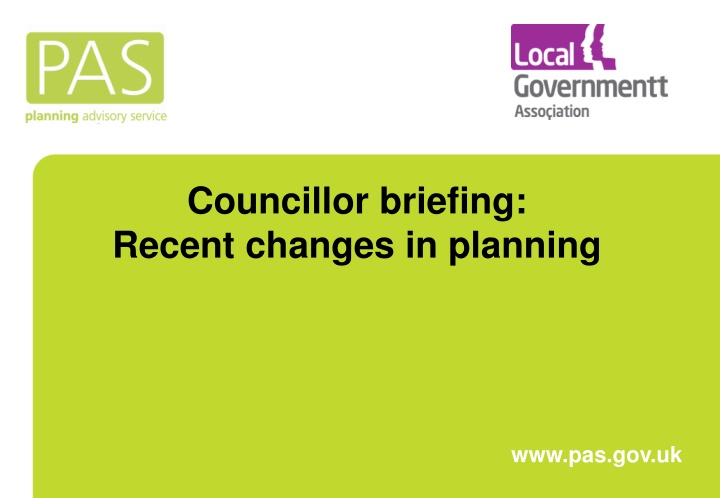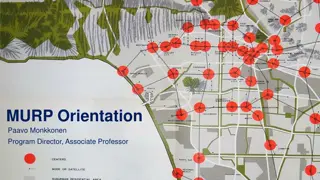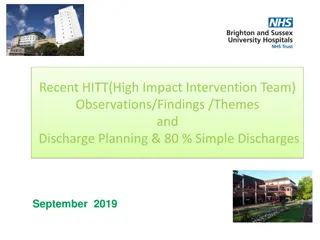
Recent Changes in Planning System Overview
Overview of recent changes in the planning system focusing on improvements in performance, streamlining processes, permitted development, policy and guidance updates, boosting housing delivery, CIL and S.106 considerations, and major infrastructure developments. Major reforms and Acts from recent years are highlighted, emphasizing the government's aim to enhance efficiency and sustainability in planning services.
Download Presentation

Please find below an Image/Link to download the presentation.
The content on the website is provided AS IS for your information and personal use only. It may not be sold, licensed, or shared on other websites without obtaining consent from the author. If you encounter any issues during the download, it is possible that the publisher has removed the file from their server.
You are allowed to download the files provided on this website for personal or commercial use, subject to the condition that they are used lawfully. All files are the property of their respective owners.
The content on the website is provided AS IS for your information and personal use only. It may not be sold, licensed, or shared on other websites without obtaining consent from the author.
E N D
Presentation Transcript
Councillor briefing: Recent changes in planning www.pas.gov.uk
What is PAS ? PAS is a DCLG grant-funded programme but part of the Local Government Association Governed by a sector led board 10 staff commissioners, generalists, support PAS exists to provide support to local planning authorities to provide efficient and effective planning services, to drive improvement in those services and to respond to and deliver changes in the planning system
Scope of this presentation An overview of the main changes to the planning system from January 2013 It looks in more detail at some of the significant changes e.g. Permitted Development. It looks at the impact of some of these changes. It looks at proposed changes (including those subject to consultation). Our aim is to help keep councillors abreast of the changes.
Overview of recent changes The Government wants LPAs to perform more effectively, more openly and more efficiently to deliver sustainable development and deliver their growth agenda. Under the Coalition Government, major reforms to the planning system have taken place with: Localism Act 2011 National Planning Policy Framework & Planning Practice Guidance Growth and Infrastructure Act 2013 emphasis on speeding up the planning system
Overview of recent changes (cont) Enterprise And Regulatory Reform Act 2013. The Infrastructure Act 2015 Announcements on planning reform have also been made in: Budget 2014 Technical Consultation on Planning July 2014 Consultation: planning and travellers September 2014 National Infrastructure Plan 2014 Autumn Statement 2014 Further changes in March 2015
Overview of recent changes There are a few major areas of change: improving performance (Effective) streamlining processes (Proportionate and Effective) Permitted development (Proportionate) policy and guidance (Sustainable and Simple) boosting housing delivery (Effective) CIL and S.106 (Proportionate) major infrastructure (Effective)
Improving performance Designation Named and shamed , action plan, performance above threshold, applicants can choose the Planning Inspectorate to determine majors Based on: speed (40% of majors in timescales) and quality of decisions (allowed major appeals) district and county matter applications Revised appeal procedures costs may now be awarded both on application and at the initiative of an Inspector
Streamlining processes red tape challenge streamlining the application process Consolidated Procedures Order improving the process of statutory consultation new deemed discharge of conditions Improving the use of conditions simplifying the heritage consent regime
Permitted Development main changes Changes to PD rights were made in 2013 and 2014: significant changes larger house extensions, commercial to residential use, encouraging new free schools, re-use of farm buildings changes faced opposition and have been controversial move to a three tier system PD rights for small-scale changes prior approval rights for development requiring consideration of specific issues planning permission for the largest scale development prior approval process now used much more. Resource implications for LPAs
Impact of Permitted Development changes Large increase in the number of prior approval applications Low acceptance rate for agricultural to residential changes LGA Survey looked at change of use from office to residential & house extensions Key findings: varied impact, particularly for number of prior approvals received loss of affordable units has been pronounced in Greater London, the South West and the East of England.
Impact of Permitted Development changes Key findings cont d:- different opinions on whether office-resi PD was helping to bring empty and underused premises back into use cost of administering prior approval applications was considerably higher than the set fee majority of respondents said that the impacts of the prior approval system for change of use had been negative. respondents raised concerns about: fewer refusals for larger household extensions additional workload loss of income - impact on their ability to deliver services
Policy and guidance written ministerial statement on travellers, green belt and diversity and equality in planning planning practice guidance (PPG) important clarification of national policy residential institutions can contribute to housing land supply new section 106 thresholds for small scale developers updated on a rolling basis National Planning Policy for Waste implication for Green Belt
Policy and guidance Town Centre First policy re-emphasised sustainable urban drainage change in national policy effective April 2015 applies to major development only will be material consideration for planning decisions NPPF and PPG will be revised implications for councils need policies (and SPDs?) and systems in place potential resource implications
Boosting housing delivery Increasing the supply of housing and re-using brownfield land by providing increased certainty through LDOs Housing Zones: 20 outside London, 20 inside Brownfield housing land consultation Government grants to incentivise LDO preparation
Boosting housing delivery Starter Homes change in national policy implications for dealing with planning applications Custom and self build Councils will need to keep register and reflect this in local plans Zero carbon homes exemption for small sites
Section 106 and CIL From April 2015 you will only be able to pool S106 on a very limited basis Community Infrastructure Levy (CIL) Regs amended in 2013, 2014 and 2015 Renegotiation of affordable housing Revised S.106/CIL requirements for smaller scale housing development Vacant Building Credit
Housing Standards New national policy Code for Sustainable Homes withdrawn Restriction on new and emerging local plans should not require standards exceeding the building regulations optional new national technical standards should only be required through new Local Plan policies if they address a clearly evidenced need Interim measures applying existing standards
Major Infrastructure nationally significant infrastructure planning regime National Networks National Policy Statement Hazardous Waste National Policy Statement
Other changes involving people in planning compulsory pre-application for onshore wind legal & enforcement changes Enforcement Fund Judicial Review Marine planning solar energy
Contact PAS email pas@local.gov.uk web www.pas.gov.uk phone 020 7664 3000
Appendix Changes to Permitted development : detail
Permitted Development main changes Consolidated General Permitted development Order 2015 House extensions: increasing the size limits for the depth of single- storey domestic extensions from 4m to 8m (for detached houses) and from 3m to 6m (for all other houses), in non-protected areas. Single storey only. requires consultation with neighbours
Permitted Development main changes Change of use from offices to residential: initially for a period of three years. Will this be extended? Change of use to state-funded schools for one academic year, buildings in any use class will be able to be used as a state-funded school while permanent planning permissions secured restriction on height of fencing at school accesses
Permitted Development changes change of use of agricultural buildings new Class Q (formerly MB) - Change of use from buildings used for agricultural purposes to residential use (C3) new Class S (formerly MA) - Change of use from buildings used for agricultural purposes to a state funded school or nursery providing childcare new Class R (formerly M) - change of use of a building used for agricultural purposes and any land within its curtilage to a flexible use changes to PPG - not restricted to sustainable locations
Permitted Development other changes larger extensions to offices and shops change of use from existing agricultural buildings to a range of new business uses temporary retail and office uses thresholds increased from 235m2 to 500m2 for change between business uses telecommunications relaxations to support 4G
Permitted Development other changes change of use of small retail premises to residential use change of use from a shop (A1) to a bank or a building society change of use from offices, hotels, residential, non- residential institutions, and leisure and assembly to nurseries providing childcare - subject to prior approval
Main changes in consolidated GPDO 2015 and changes to use classes storage and distribution to residential amusement arcades and casinos to residential Betting offices and pay day loan shops are removed from A2 more change of use between shops and financial and professional services, allowing the change of use to restaurants or leisure use rights for the installation of solar panels on non- domestic buildings.






















